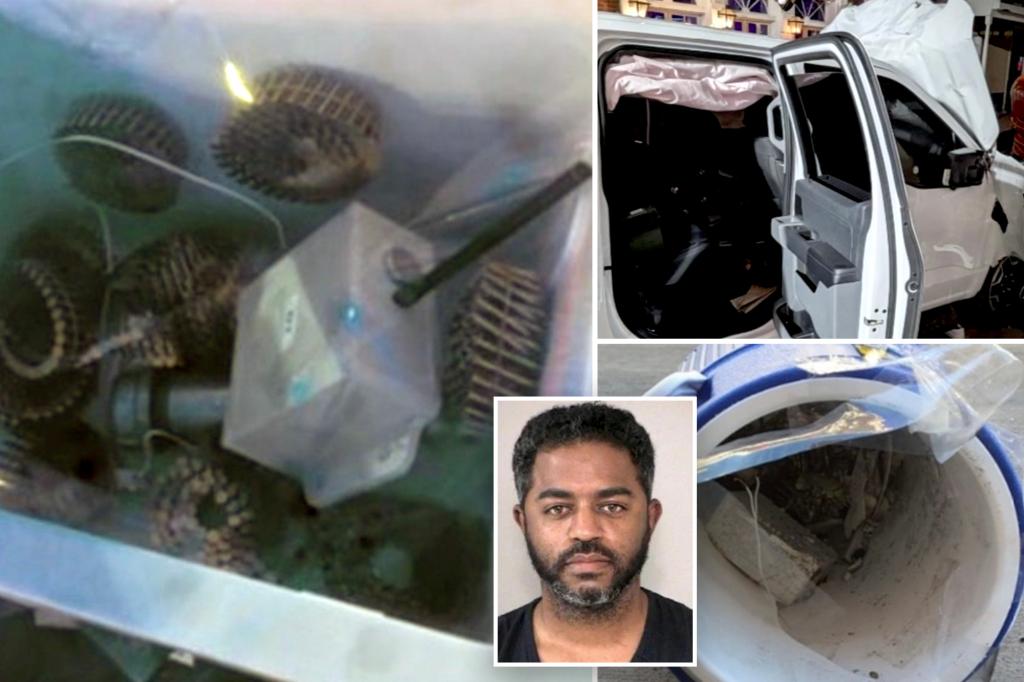The foiled New Year’s Day terrorist attack on Bourbon Street in New Orleans, orchestrated by Shamsud-Din Jabbar, has unveiled a chilling plot involving homemade bombs designed to inflict mass casualties. Newly released images provide a stark visual of these deadly devices, revealing steel pipes bristling with nails and connected to a radio-controlled receiver. These bombs, intended to amplify the carnage after Jabbar’s initial attack of plowing a truck into the crowd, thankfully failed to detonate due to the swift actions of the New Orleans Police Department, who shot and killed Jabbar before he could activate the explosives. This act of heroism undoubtedly saved countless lives and prevented a far greater tragedy.
The intricate design of the bombs speaks to a level of planning and preparation that is deeply unsettling. The use of readily available materials, such as electric matches and hobby switches, combined with a rare explosive compound previously unseen in terrorist attacks in the US or Europe, highlights Jabbar’s resourcefulness and the potential danger posed by individuals with access to such knowledge and materials. The fact that Jabbar, a US Army veteran, possessed the skills to construct these devices raises concerns about the potential for radicalized individuals with military training to carry out similar attacks.
The scope of Jabbar’s plot extended beyond the bombs themselves. Images also reveal glass jars filled with flammable liquids found in the rental truck, indicating a multi-pronged approach aimed at maximizing destruction and casualties. This combination of explosives and incendiaries underscores the calculated nature of the attack and the intent to inflict widespread harm. The discovery of a bomb-making workbench in Jabbar’s Texas home, along with a stash of chemical bottles and a list of bomb-making compounds, further solidifies the premeditation and meticulous planning that went into this thwarted attack.
Jabbar’s path to radicalization and the motivations behind the attack remain under investigation. His documented support for ISIS, including Facebook videos posted during his drive from Houston to New Orleans, paints a picture of a man embracing extremist ideology. The ISIS flag attached to the rental truck serves as a chilling symbol of his allegiance to the terrorist group. His personal history, including three divorces and over a decade of military service, may offer clues into the factors that led him down this destructive path. However, unraveling the complex web of influences and motivations that drive individuals to commit such acts of terror remains a significant challenge for law enforcement and intelligence agencies.
The discovery of bomb-making materials in Jabbar’s Airbnb rental on Mandeville Street, coupled with his attempt to set fire to the property, suggests an effort to destroy evidence and cover his tracks. This act of attempted arson further underscores his awareness of the gravity of his actions and the desire to evade capture and accountability. The thoroughness of his planning, from the construction of the bombs to the attempted destruction of evidence, highlights the serious threat he posed.
The averted New Year’s Day massacre serves as a stark reminder of the persistent threat of terrorism and the need for constant vigilance. The use of readily available materials, combined with the ingenuity and technical skills displayed by Jabbar, underscores the evolving nature of terrorism and the challenges faced by law enforcement in preventing such attacks. Understanding the motivations and methods of individuals like Jabbar is crucial in developing effective counter-terrorism strategies and safeguarding public safety. The incident also highlights the importance of community vigilance and reporting suspicious activities to authorities, as these actions can play a critical role in preventing tragedies.
Furthermore, the case raises questions about the potential for radicalization within veteran communities and the need for support systems to address the psychological and emotional challenges faced by returning service members. The investigation into Jabbar’s background and the factors that led him to embrace extremism will likely shed light on these complex issues and inform future efforts to prevent similar acts of violence. The incident serves as a wake-up call to the ongoing need for vigilance, preparedness, and community engagement in the face of evolving terrorist threats.

